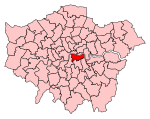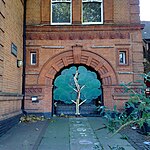St Philip's Church, Avondale Square
20th-century Church of England church buildingsAC with 0 elementsAnglican Diocese of SouthwarkChurch of England church buildings in the London Borough of SouthwarkChurches completed in 1963 ... and 2 more
Nugent Cachemaille-Day buildingsUse British English from July 2021

St Philip's Church, Avondale Square (also known as St Philip the Apostle, Camberwell and St Philip and St Mark's, Camberwell) is a parish church within the Avondale Square Estate in Camberwell in the London Borough of Southwark. It is dedicated to St Philip the Apostle. The church is in the Archdeaconry of Southwark, in the Diocese of Southwark.
Excerpt from the Wikipedia article St Philip's Church, Avondale Square (License: CC BY-SA 3.0, Authors, Images).St Philip's Church, Avondale Square
Avondale Square, London Old Kent Road (London Borough of Southwark)
Geographical coordinates (GPS) Address Nearby Places Show on map
Geographical coordinates (GPS)
| Latitude | Longitude |
|---|---|
| N 51.4866 ° | E -0.0694 ° |
Address
Tovy House
Avondale Square
SE1 5EY London, Old Kent Road (London Borough of Southwark)
England, United Kingdom
Open on Google Maps







